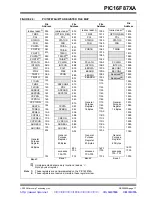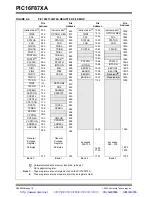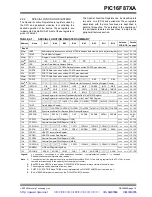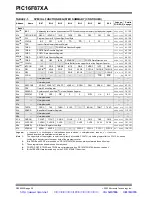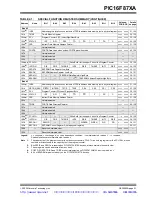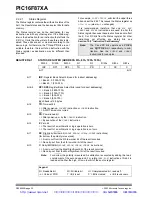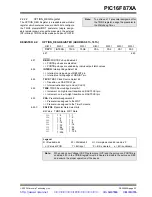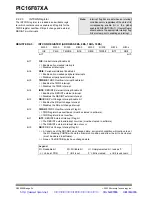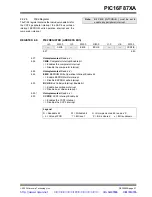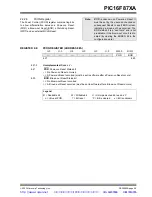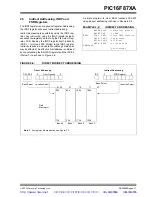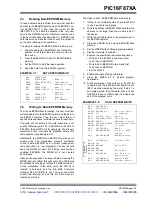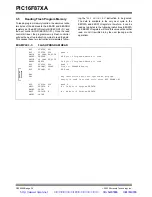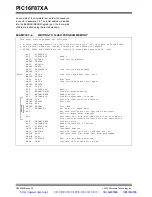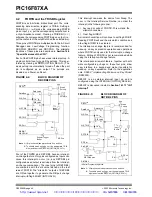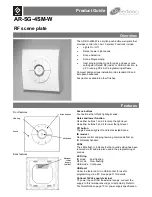
PIC16F87XA
DS39582B-page 30
2003 Microchip Technology Inc.
2.3
PCL and PCLATH
The Program Counter (PC) is 13 bits wide. The low
byte comes from the PCL register which is a readable
and writable register. The upper bits (PC<12:8>) are
not readable, but are indirectly writable through the
PCLATH register. On any Reset, the upper bits of the
PC will be cleared. Figure 2-5 shows the two situations
for the loading of the PC. The upper example in the
figure shows how the PC is loaded on a write to PCL
(PCLATH<4:0>
→
PCH). The lower example in the
figure shows how the PC is loaded during a
CALL
or
GOTO
instruction (PCLATH<4:3>
→
PCH).
FIGURE 2-5:
LOADING OF PC IN
DIFFERENT SITUATIONS
2.3.1
COMPUTED GOTO
A computed
GOTO
is accomplished by adding an offset
to the program counter (
ADDWF PCL
). When doing a
table read using a computed
GOTO
method, care
should be exercised if the table location crosses a PCL
memory boundary (each 256-byte block). Refer to the
application note, AN556, “Implementing a Table Read”
(DS00556).
2.3.2
STACK
The PIC16F87XA family has an 8-level deep x 13-bit
wide hardware stack. The stack space is not part of
either program or data space and the stack pointer is not
readable or writable. The PC is PUSHed onto the stack
when a
CALL
instruction is executed, or an interrupt
causes a branch. The stack is POP’ed in the event of a
RETURN
,
RETLW
or a
RETFIE
instruction execution.
PCLATH is not affected by a PUSH or POP operation.
The stack operates as a circular buffer. This means that
after the stack has been PUSHed eight times, the ninth
push overwrites the value that was stored from the first
push. The tenth push overwrites the second push (and
so on).
2.4
Program Memory Paging
All PIC16F87XA devices are capable of addressing a
continuous 8K word block of program memory. The
CALL
and
GOTO
instructions provide only 11 bits of
address to allow branching within any 2K program
memory page. When doing a
CALL
or
GOTO
instruction,
the upper 2 bits of the address are provided by
PCLATH<4:3>. When doing a
CALL
or
GOTO
instruc-
tion, the user must ensure that the page select bits are
programmed so that the desired program memory
page is addressed. If a return from a
CALL
instruction
(or interrupt) is executed, the entire 13-bit PC is popped
off the stack. Therefore, manipulation of the
PCLATH<4:3> bits is not required for the
RETURN
instructions (which POPs the address from the stack).
Example 2-1 shows the calling of a subroutine in
page 1 of the program memory. This example assumes
that PCLATH is saved and restored by the Interrupt
Service Routine
(if interrupts are used).
EXAMPLE 2-1:
CALL OF A SUBROUTINE
IN PAGE 1 FROM PAGE 0
PC
12
8
7
0
5
PCLATH<4:0>
PCLATH
Instruction with
ALU
GOTO,CALL
Opcode <10:0>
8
PC
12
11 10
0
11
PCLATH<4:3>
PCH
PCL
8
7
2
PCLATH
PCH
PCL
PCL as
Destination
Note 1: There are no status bits to indicate stack
overflow or stack underflow conditions.
2: There are no instructions/mnemonics
called PUSH or POP. These are actions
that occur from the execution of the
CALL
,
RETURN
,
RETLW
and
RETFIE
instructions
or the vectoring to an interrupt address.
Note:
The contents of the PCLATH register are
unchanged after a
RETURN
or
RETFIE
instruction is executed. The user must
rewrite the contents of the PCLATH regis-
ter for any subsequent subroutine calls or
GOTO
instructions.
ORG 0x500
BCF PCLATH,4
BSF PCLATH,3
;Select page 1
;(800h-FFFh)
CALL SUB1_P1
;Call subroutine in
:
;page 1 (800h-FFFh)
:
ORG 0x900
;page 1 (800h-FFFh)
SUB1_P1
:
;called subroutine
;page 1 (800h-FFFh)
:
RETURN
;return to
;Call subroutine
;in page 0
;(000h-7FFh)
http://www.xinpian.net
提供单片机解密、IC解密、芯片解密业务
010-62245566 13810019655


